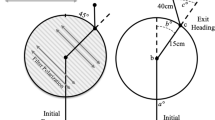Abstract
Synthetic pheromone was released from a dispenser stretched across the width of a wind tunnel. Beetles in pheromone-free wind wandered in all directions and did not appear to orient to the wind. A dosage series showed that pheromone decreased the walking rate and deviations from the upwind direction, and it increased the turning rate. The tracks were composed of relatively straight or gently curving sections interspersed with more infrequent, larger course adjustments. Although pheromone clearly affected the average heading of beetles within a treatment, any given individual exposed to pheromone did not necessarily head directly upwind or maintain a fixed absolute angle with respect to the wind direction. The response appeared to be an inaccurate anemotaxis, rather than an anemomenotaxis.
Similar content being viewed by others
References
Akers, R.P. 1985. Olfactory discrimination and orientation by femaleIps paraconfusus Lanier (Coleoptera: Scolytidae) to components of the male pheromone. PhD thesis. University of California, Berkeley. 231 pp.
Akers, R.P. 1989. Counterturns initiated by a decrease in the rate of increase of concentration: A possible mechanism of chemotaxis by walking femaleIps paraconfusus bark beetles.J. Chem. Ecol. 15:183–208.
Akers, R.P., andWood, D.L. 1989. Olfactory orientation responses by walking femaleIps paraconfusus bark beetles: I. Chemotaxis assay.J. Chem. Ecol. 15:3–24.
Batschalet, E. 1981. Circular Statistics in Biology. Academic Press, New York. 371 pp.
Bell, W.J., andTobin, T.R. 1982. Chemo-orientation.Biol. Rev. 57:219–260.
Borden, J.H., andWood, D.L. 1966. The antennal receptors and olfactory response ofIps confusus (Coleoptera: Scolytidae) to male sex attractant in the laboratory.Ann. Entomol. Soc. Am. 59:253–261.
Browne, L.E. 1972. An emergence cage and refrigerated collector for wood-boring insects and their associates.J. Econ. Entomol. 65:1499–1501.
Byers, J.A., andWood, D.L. 1981. Interspecific effects of pheromone on the attraction of the bark beetlesDendroctonus brevicomis andIps paraconfusus in the laboratory.J. Chem. Ecol. 7:9–18.
Choudhury, J.H., andKennedy, J.S. 1980. Light versus pheromone-bearing wind in control of flight direction by bark beetles,Scolytus multistriatus.Physiol. Entomol. 5:207–214.
David, C.T., andKennedy, J.S. 1987. The steering of zigzagging flight by male gypsy moths.Naturwissenschaften 74:194–196.
Gara, R.I. 1963. Studies on the flight behavior ofIps confusus (LeC.) (Coleoptera: Scolytidae) in response to attractive material.Contrib.Boyce Thompson Inst. 22:51–66.
Kennedy, J.S. 1977a. Olfactory responses to distant plants and other odor sources, pp. 67–92,in H.H. Shorey and J.J. McKelvey, Jr. (eds.). Chemical Control of Insect Behavior. John Wiley & Sons, New York.
Kennedy, J.S. 1977b. Behaviorally discriminating assays of attractants and repellents, pp. 215–229,in H.H. Shorey and J.J. McKelvey, Jr. (eds.). Chemical Control of Insect Behavior. John Wiley & Sons, New York.
Kennedy, J.S. 1978. The concepts of olfactory “arrestment” and “attraction”.Physiol. Entomol. 3:91–98.
Kennedy, J.S., Ludlow, A.R., andSanders, C.J. 1980. Guidance system used in moth sex attraction.Nature 288:475–477.
Kramer, E. 1975. Orientation of the male silkmoth to the sex attractant bombykol, pp. 329–335,in D.A. Denton and J.P. Coghlan, (eds.). Olfaction and Taste, Vol. V. Academic Press, New York.
Preiss, R., andKramer, E. 1986. Mechanism of pheromone orientation in flying moths.Naturwissenschaften 73:555–557.
Silverstein, R.M., Rodin, J.O., andWood, D.L. 1966. Sex attractants in frass produced by maleIps confusus in ponderosa pine.Science 154:509–510.
Willis, M.A., andBaker, T.C. 1987. Comparison of manoeuvres used by walking versus flyingGrapholita molesta males during pheromone-mediated upwind movement.J. Insect Physiol. 33:875–883.
Wood, D.L., andBushing, R.W. 1963. The olfactory response ofIps confusus (LeConte) (Coleoptera: Scolytidae) to the secondary attractant in the laboratory.Can. Entomol. 95:1066–1078.
Wood, D.L., Browne, L.E., Silverstein, R.M., andRodin, J.O. 1966. Sex pheromones of bark beetles: I. Mass production, bioassay, source and isolation of the sex pheromone ofIps confusus (LeC.).J. Insect Physiol. 12:523–536.
Wood, D.L., Stark, R.W., Silverstein, R.M., andRodin, J.O. 1967. Unique synergistic effects produced by the principal sex attractant compounds ofIps confusus (LeConte) (Coleoptera: Scolytidae).Nature 215:206.
Author information
Authors and Affiliations
Rights and permissions
About this article
Cite this article
Patrick Akers, R., Wood, D.L. Olfactory orientation responses by walking femaleIps paraconfusus bark beetles. J Chem Ecol 15, 1147–1159 (1989). https://doi.org/10.1007/BF01014818
Received:
Accepted:
Issue Date:
DOI: https://doi.org/10.1007/BF01014818




